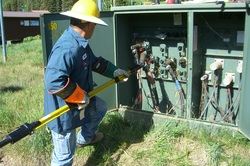
The high voltage 12,460 comes in on the left, where he's working, and the low voltage from the transformer, comes out on the wires on the right. The transformer drops the high voltage from transmission levels, to working voltage levels, like 480 volts. This is a very common voltage used in industrial applications. This is also 3 phase power, 3 hot wires, Both on the high and the low voltage side.

